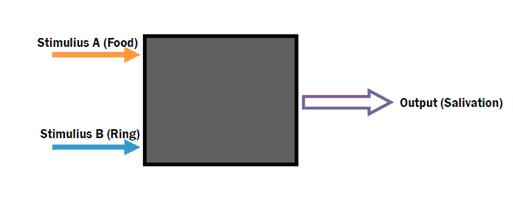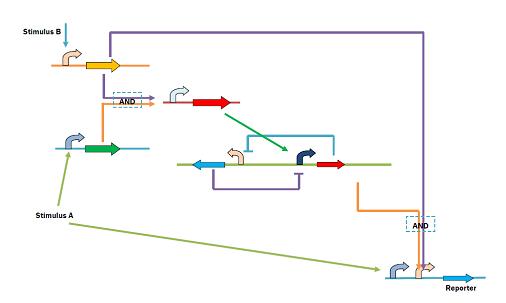Project > Summary
Project Summary
A school bell rings and you suddenly feel anxious, nervous - you begin to sweat, fret. Though it's been years since that school bell commanded you, it still brings the same stress, reminding you of the dreaded math test next period. Though the school bell should not be connected to anxiety naturally, your brain has connected it to the following test, thus exhibiting classical conditioning. And now our E.coli are equipped with a system similar to such, exhibiting both learning and memory.
Dr. Ivan Pavlov conducted his experiment with food and a bell (as well as other arbitrary stimuli but for conciseness, only the bell will be mentioned). Naturally, the bell causes no such salivation. However, after a training session in which both the food and ringing are simultaneously displayed, the dog builds a relationship between the bell and food and kept their association in its memory. Thus, simply the ringing alone can cause salivation; Dr. Pavlov called this the “conditioned reflex.” Not only did Dr. Pavlov was entitled the 1904 Nobel Prize in Physiology and Medicine for this work, but his contribution was, and still is a milestone for the research of learning and cognition.
Elaborating upon the mechanism of the Conditioned Reflex (the correlation between two objects being memorized by the brain), it is thought to be the result of two neurons simultaneously working together, which led to modification of memory. As the famous Hebbian Rule states, “Firing together, wiring together.” This theory is the basis of the “Artificial Neural Network”, which modifies the connectivity of two nodes in the network according to the concurrence of activity. Connectivity increases if the two nodes are activated or repressed at the same time; otherwise, the connectivity is weakened. Molecular mechanism for this learning rule was discovered later in the form of “Long Term Potentiation” and “Long Term Depression”.
This year, the PKU iGEM team wants to build an E. coli version of the classical “conditioned reflex experiment.” Dr. Pavlov had his dogs, we have our E. cogs(the combination of E.coli and dogs).
Our memory system is essentially a “black box” – it senses two stimuli, but it’s up to decide how to construct it.

When the system is at its original state, the presence of stimulus A will lead to an output; stimulus B, however, will lead to no such output. After a few training sessions with both the stimuli A & B, the state of the black box is modified, in which the presence of either stimuli alone can lead to the desired response. Our E. cogs thus have a sequential logic involving internal memory quite similar to Pavlov’s dogs. For our circuit, we used small molecules in environment as inputs (stimuli A &B), inducible promoters as the sensors, a bistable switch as the module of memory, and combined AND Gate and OR Gate to connect all these modules. The complete circuit is illustrated in the image below.

Our circuit demonstrates a new, integrated organization which mimics associative learning in high-level animals. The environment naturally is complex and adorned with several bells and whistles; and here we tried to create a circuit which exemplifies Hebbian learning in E. coli, so that they could adapt to the environment themselves. Consider the condition where two factors (e.g. humidity and temperature) in environment are correlated in a structure which is stable for some time but changeable in a larger time scale. For example, these two factors are positively correlated for some months, but weakly correlated for other time. And so in such environment our E. coli could learn the associations and even updated its memory according to the changes in environment; in this way, some intelligent behaviors could be performed based on its stored memory.
Memory and learning are two motifs popular in both iGEM and out; such processes can act as the basis of more complex and intelligent circuits in synthetic biology. Seeing our E. cogs learn and respond is but the first step to so many others in the future. As synthetic biology often is, it is not an exact copy, but a model nonetheless. As the groundbreaking work of Pavlov in our understanding on the function of nervous system, our E. cogs are yet another milestone on the way to creating intelligent machines in synthetic biology.
^Top
|